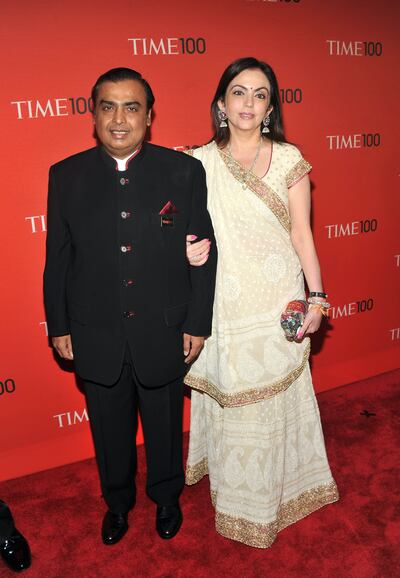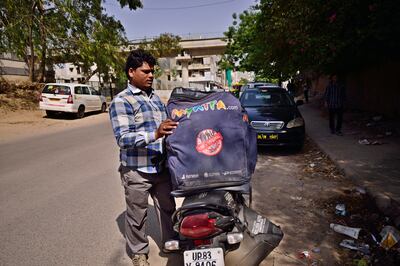
The Business of Fashion
Agenda-setting intelligence, analysis and advice for the global fashion community.

Agenda-setting intelligence, analysis and advice for the global fashion community.

DELHI, India — Priya Jambh is a woman on a mission. As a sales consultant living in a small town near Panchkula in the state of Haryana, she has a stressful job which is only compounded by the fact that she volunteers for a frontline charity. To let off steam, Jambh does what many middle-class twenty-somethings do across India. She shops.
“I couldn’t buy anything whilst the full lockdown was in place. Malls and markets were closed and online it was just delivery of essentials allowed,” she said, referring to the country’s Covid-19 restrictions, which were some of the harshest in the world.
With most of parties and family events cancelled, Jambh’s social calendar was completely interrupted but she was still motivated to spend on fashion. “I have a lot of meetings online now, so I really needed some new tops and earrings.”

Myntra's mobile app | Source: Shutterstock
ADVERTISEMENT
Since restrictions on non-essential e-commerce were recently relaxed, Jambh decided to release some of the proverbial pent-up demand that mounted during lockdown. “I [just] bought H&M and Roadster joggers, a cute pink Mango top that was on sale, some jhumkas (traditional style earrings) and an Anouk kurta all from Myntra.”
It is not just Jambh’s shopping basket that provides an interesting snapshot of the latest consumer behaviour in India. If the coronavirus had arrived only a few years earlier, Jambh suggests, the online shopping experience for Indian consumers would have looked very different. The implication being that — without effective e-commerce — India’s post-pandemic economic recovery would be even harder than it is now.
“Arey yaar!” she exclaimed, using the Hindi slang for ‘you’ve got to be kidding me’. “It used to be so difficult to buy things online [and] parcels were always getting lost. But now the delivery is quick and usually reliable. They do it through my local kirana; they know my household well [at that store].”
Kiranas are small local independent ‘mom and pop shops’ that sell groceries and a variety of other merchandise. Owners of kiranas typically have unparalleled knowledge of their localities: especially important as most of India’s streets have a complex system of alphabetical block and house numbers that can confound even the most up to date GPS system.
Most e-commerce players are now creating tie-ups with physical pick-up points in a bid to overcome some of the difficulties in delivering to Indian consumers beyond urban centres — and kiranas have become a central component of this strategy. The pandemic has only accelerated the trend for players like Myntra. With its Myntra Extended Network Through Store Activation (Mensa) network, the e-commerce giant has already partnered with over 15,000 small shops across India in order to reach so-called “last mile” consumers.
Meanwhile, Amazon India has also been investing in its last mile logistics service, which is buoyed by its HIS, DSP and Amazon Flex networks. As solutions like these continue to reduce friction and pain points for Indian consumers, e-commerce becomes an increasingly attractive channel, especially for those living outside the major metropoles. The market remains one of the most underserved in the world.
By 2021 it is expected that more than 900 million Indian consumers will be online, with the e-commerce market as a whole predicted to grow to $84 billion according to a Deloitte and Retail Association of India report. It is already worth more than $43 billion, according to figures from Statista.
Small Town Dreams Demand Big Business Strategies
ADVERTISEMENT
For many e-commerce players, it is estimated that more than half of their Indian customer base is from second and third tier cities and towns. Indeed, Myntra’s most recent sale saw over fifty-six per-cent of orders go to these areas.
Myntra, a pure-play e-commerce company (whose parent company Flipkart saw Walmart buy a majority stake in 2018), has emerged as a market leader for millennials in the affordable fashion e-commerce space. It is host to over eighteen private labels as well as international fast fashion brands including Mango, Boohoo, French Connection and Forever 21.
Myntra’s younger and smaller rival Ajio, which sells international brands like Superdry, Guess and Scotch & Soda, is also testing the waters of last-mile delivery by tying up with Jio data and phone sales stores (the company’s website states they have a Jio store presence in over 6,000 cities and towns across India). Customers can order from dedicated Ajio service points as well as collect and return their orders.
Ajio is an important player to watch because it is owned by a subsidiary of the conglomerate Reliance Industries, which has direct partnerships with brands like Ermenegildo Zegna, Diesel and Bally and has a stake in Genesis Luxury Fashion, the Indian group that has a joint venture with Burberry and distributes brands like Bottega Veneta and Coach.
In a complex but potentially lucrative market, some believe there is a gap for an Indian luxury e-commerce player that can offer a locally relevant edit of the latest collections.
Recent reports suggest Reliance is planning to launch just that. Some believe it could be pitched as India’s answer to Net-a-Porter.
"Indians have always loved to shop on their travels abroad," Priya Tanna, Editor-in-Chief of Vogue India said. "As an extension when they are shopping online, they tend to frequent the e-commerce sites of the department stores they are familiar with such as saksfifthavenue.com, neimanmarcus.com, bergdorfgoodman.com, harrods.com and so on. Net-a-Porter also has quite the loyal following as does Matches Fashion and Moda Operandi is also growing in popularity for its curated mix of global talent."
Online luxury shopping is key for many consumers in high-growth second and third tier city markets which are far from luxury stores. Even for those in India's large metropolises, many independent high-end designer labels like Dries Van Noten and Jacquemus are only available offline at multi-brand retailers like Mumbai-based boutique Le Mill — though Le Mill just launched its own e-commerce site this June.
ADVERTISEMENT

Chairman of Reliance Industries, Mukesh Ambani at the TIME 100 Gala in 2011
| Source: Getty Images
A common complaint amongst high net worth customers is that the small selection at India's relatively small number of physical monobrand luxury stores is based on a limited edit of the collections of brands like Gucci, Louis Vuitton and Burberry. What's more, customs duties were recently increased by the government as part of its "Make in India" drive.
“The biggest issue [for luxury e-commerce is still] the import duty [at] approximately 30 to 35 percent making luxury products much more expensive in India. Adding to that is arbitrary custom duties [that are] sometimes equal to or higher than the value of the goods and extensive paperwork, resulting in goods often being held back [which] makes the shopping experience far from seamless,” says Tanna.
Closer to home, a few premium to entry-level international luxury brands like Michael Kors and Armani Exchange are available online through portals like Tata-Cliq Luxury. There are a host of much smaller local platforms like Faballey, which offer private label merchandise at price points on average a third to half that of international brands. But it hasn't been plain sailing for everyone. Koovs, which made a splash back in 2012 in a bid to become India's answer to Asos, went into administration in 2019.
Amazon flexed its fashion muscles early on in India by sponsoring several seasons of Delhi’s fashion week from 2015-2018. For a while it also carried a portal dedicated to established and emerging Indian designers as part of its offering. However, as in other global markets, Amazon in India tends to be primarily associated with the value segment and lacks the immersive fashion-led content which competitors like Myntra have excelled in. Amazon India has also run into some serious regulatory hurdles.
While fashion e-commerce is a potentially lucrative market, it is one beset with challenges in India — for foreign players especially.
Techno-Nationalism During a Foreign Investment Bonanza
On June 29, following escalating geopolitical tensions with China, the Indian government banned 59 Chinese apps from operating within India. With a single stroke, India’s estimated 200 million TikTok users were affected and millions more who used popular Chinese fast-fashion apps like She-in and Club Factory could no longer purchase from these companies.
Back in 2018, foreign e-commerce players like Amazon saw how India’s volatile regulatory landscape could impact business. Amazon’s Indian operations were stymied by the government’s tightening of rules for FDI (foreign direct investment) in e-commerce. India only allows foreign e-commerce firms to operate marketplace platforms on which third-parties sell goods to retail consumers.
Amazon was allegedly circumventing those rules by creating proxy suppliers or vendors. Even though Amazon denied the allegations, the giant will be hit with a new digital service tax that Fitch Solutions Consumer & Retail Analyst, Taohai Lin warns, “will give advantage to local e-commerce players.”
In light of this, Facebook’s decision in May of this year to partner with Reliance through a 9.99 percent stake worth $5.7 billion seems wise. Reliance Jio Platforms plans to use WhatsApp (owned by Facebook, Reliance’s newly minted investment partner) to create a messaging and delivery platform. Although this is currently slated for grocery delivery, experts predict Reliance will extend this to electronic goods and apparel in the future.
The Facebook investment was swiftly followed by an investment bonanza where companies as diverse as LVMH-backed private equity firm L Catterton, American player Silver Lake Partners, Abu Dhabi’s sovereign wealth fund Mubadala and Google all acquired a stake in Reliance Jio during the coronavirus pandemic.
Between April and mid-July, Reliance Industries Chairman Mukesh Ambani had attracted over $20 billion of investment (according to the Financial Express) in Reliance Jio Platforms for what experts say is Ambani’s plan for Reliance to become a global force in the vein of China’s Alibaba.
"Facebook's huge investment shows they think Reliance are set to dominate Indian tech and e-commerce just as Amazon or Alibaba have done in the US and China,” said James Crabtree, associate professor of practice at the Lee Kuan Yew School of Public Policy at the National University of Singapore, and author of the book The Billionaire Raj.
“And rather than risking coming into conflict with billionaire [and Reliance Industries chairman] Mukesh Ambani's ever-growing ambitions, they have clearly decided it is safer to join together with him instead,” he added.
A Post-Pandemic Shake-Up
Data released in 2019 by McKinsey’s FashionScope predicted that India’s apparel market will be worth $59.3 billion in 2022, making it the sixth largest in the world. The online segment of India’s fashion market is growing the fastest at a compound annual growth rate (CAGR) of approximately 32 percent, according to a report by RedSeer consulting, a research and advisory firm.
But with Covid-19 predicted to have significant long-term impacts on the way consumers shop, these forecasts have been made redundant. How will India’s fashion e-commerce market evolve and where should brands invest?

A delivery person from Myntra.com | Source: Getty Images
“Apparel sales are one of the hardest hit sectors across the globe, and even e-commerce apparel sales continue to decline in double digits (-12 percent) two months after the lockdown in China. This will hold in India as well, as consumers focus on essential purchases (food, drink, health) over non-essentials,” says Lin of Fitch Solutions.
In the immediate weeks following lifting of the ban on online sales, Myntra reported a boost in sales of athleisure, with “lounge pants and joggers” witnessing an eight fold increase from pre-lockdown daily sales, according to Ayyappan Rajagopal, head of business, at Myntra. “After analysing consumers' wish-listing behaviour during the lockdown, we expect athleisure to remain in demand for the rest of the year.”
However, except for a few bright spots, it is clear that brands and e-commerce players will have to pivot to cater to a more subdued market and shifting consumer behaviour, said Darshan Mehta, president and chief executive of Reliance Brands (a subsidiary of Reliance Industries).
“Overall, we estimate that the fashion market in India will [temporarily] contract between 10 to 15 percent. The mid-market brands backed by weak operators will bear the largest brunt of this contraction. The bottom of the pyramid brands that cater to the value segment and who have a robust online presence, have graduated to a sophisticated omnichannel environment, will gain market share,” he forecasted.
Some analysts predict that existing trends that have seen consumers shift to e-commerce will only be bolstered by the uncertainty now hanging over public spaces where the risk of infection is still high.
"Over the past few years malls have seen a shift from around 7-10 percent of space being occupied by food and beverages to the current average of 25-30 percent. That's a direct reflection of changing consumer behaviour where people are shopping more online and malls are having to work to find other uses for empty units," said Rasul Bailay, Assistant Editor at The Economic Times, who has covered India's retail sector for over twenty-five years.
Bailay adds that showrooming is also becoming more prevalent across the country, where consumers use physical stores to browse but then buy online — and often from a different retailer altogether. The impact of Covid-19 on the consumer psyche is only likely to deepen the trend away from malls, and towards immersive online user experiences.
Adding Services Like Doorstep Alterations and Styling Masterclasses
A recent survey by TechArc revealed that "convenience and choice" are now becoming more important than discounts alone for driving consumers online. Senior technology analyst and founder of the firm, Faisal Kawoosa contended that "the shift is happening but online players like Amazon and Flipkart and Myntra will have to do a lot of education around these two factors and gradually move away from the discounts pitch."
Myntra is considered a leader in the content-led approach to enhancing customer experience and engagement on its platform. Harish Narayanan, Myntra’s chief marketing officer reports that the firm’s consumer research indicated a strong desire for fashion advice and guidance. In response, they launched the Myntra Insider Masterclasses to provide a special opportunity for customers to get fashion tips from leading celebrity stylists.
“The Masterclasses offer our customers an unparalleled experience of hearing directly from the best in the industry and also interacting with them by asking questions,” Narayanan said.
Bailay warns that despite the growing attraction of e-commerce, issues of “touch and feel” and returns still plague the Indian market.
Until around ten years ago, a thriving economy of hundreds of thousands of small informal tailors across Indian cities, towns and villages were a primary way in which clothing was purchased. Consumer analysts remark on how quickly the culture of personal tailoring has been swept aside for ready to wear but how consumers retain their expectations for clothes that fit very well.
To fill the void, Myntra recently launched its “alteration at doorstep” service, which connects a national network of 500 tailors in 13 cities to local customers and allows them to alter purchases at no extra cost rather than return them. So far, Myntra has reported a reduction in returns as a result, but the business case for the service is unclear since they are underwriting the cost of alterations in a bid to stay ahead of the competition and build customer loyalty.
Increasingly, e-commerce players and brands alike will have to take the long view whilst constantly adapting to the needs of the Indian consumer in a market defined by razor sharp competition and a plethora of discounted options — now complicated by the looming recession caused by the pandemic.
Kapil Makhija, chief executive of SaaS (Software as a Service) e-commerce platform Unicommerce notes that the fashion sector has recovered some 70 percent of its pre-lockdown sales. However, shopping cart size has shrunk by an average of 25 percent.
In a cutthroat market, fashion brands will have to compel their e-commerce partners to work harder than ever to lure and retain middle class consumers with so much choice at their fingertips. In this sense, Reliance with its 360 degree service menu cutting across mobile data provision, cheap video calls, WhatsApp-driven delivery networks and retail platforms is already quadruple threat.
If Reliance then decides to push Ajio further as well as develop luxury e-commerce, then Myntra, Amazon and other smaller players will have to discount or innovate to keep up with this leviathan-in-the-making.
Related Articles:
[ Seizing the India OpportunityOpens in new window ]
[ Is India the Solution to Fashion’s Woes?Opens in new window ]
[ India’s Fashion Business Billionaires Offer Clues to Cracking the MarketOpens in new window ]
This week’s round-up of global markets fashion business news also features Latin American mall giants, Nigerian craft entrepreneurs and the mixed picture of China’s luxury market.
Resourceful leaders are turning to creative contingency plans in the face of a national energy crisis, crumbling infrastructure, economic stagnation and social unrest.
This week’s round-up of global markets fashion business news also features the China Duty Free Group, Uniqlo’s Japanese owner and a pan-African e-commerce platform in Côte d’Ivoire.
Affluent members of the Indian diaspora are underserved by fashion retailers, but dedicated e-commerce sites are not a silver bullet for Indian designers aiming to reach them.